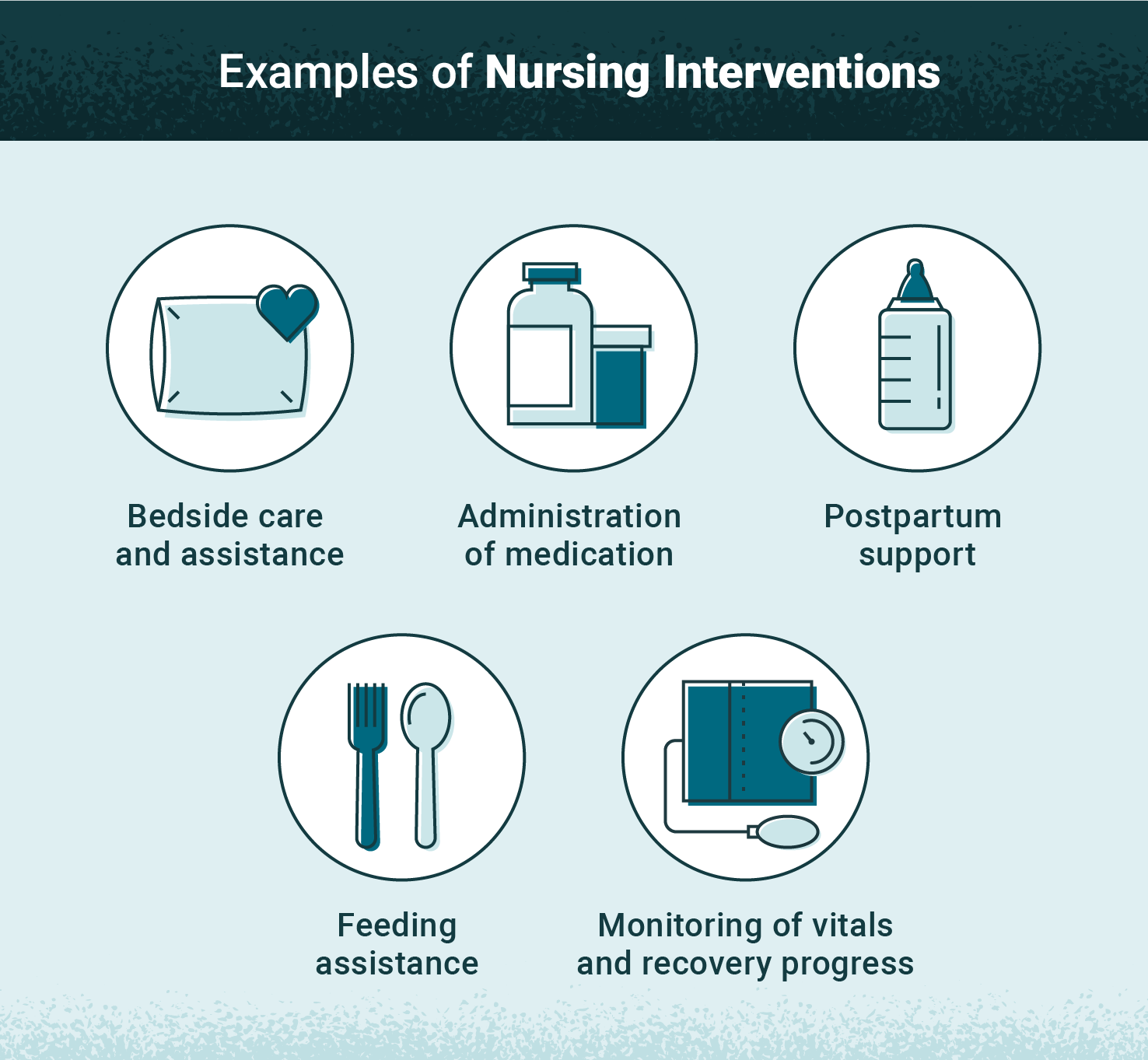nursing intervention
nursing intervention

Nursing intercessions are moves a medical caretaker initiates to execute their patient consideration plan, including any therapies, strategies, or showing minutes expected to work on the patient’s solace and wellbeing. ((nursing mediation. (n.d.) Clinical Word reference. (2009). Recovered April 22, 2021, https://clinical dictionary.thefreedictionary.com/nursing+intervention))
These activities can be basically as straightforward as changing the patient’s bed and resting position — or as involved as psychotherapy and emergency advising. While some nursing intercessions are physicians’ instructions, nurture professionals can likewise foster requests utilizing standards of proof-based practice. Normal nursing intercessions include:
- Bedside care and assistance
- Administration of medication
- Postpartum support
- Feeding assistance
- Monitoring of vitals and recovery progress

Nursing Intervention Categories
According to the role of the healthcare professional involved in the patient’s care, nursing interventions are divided into three categories: (RN Speaks, “Nursing Interventions – The Core of Nursing Process,” Sept. 3, 2020, https://rnspeak.com/nursing-interventions/)
- Independent: Without the assistance of other medical personnel, a nurse can carry out independent interventions; e.g., the routine tasks of nursing, like checking vital signs.
- Dependent: Prescription of new medications, for example, necessitates guidance or input from a medical professional. Dependent interventions cannot be initiated by a nurse alone.
- Interdependent: Interdependent or collaborative interventions involve members of a team from different fields. Post-surgery, for example, may necessitate the use of a doctor-prescribed medication, nursing assistance with feeding, and therapy from a physical or occupational therapist as part of the patient’s recovery plan.
The Role of Assessments
The first step in the nursing care plan is the nursing assessment. To learn more about a patient’s health and well-being, both doctors and nurses may conduct tests and ask questions during the assessment process. Patients’ information is gathered by professionals:
- Vital signs
- Physical complaints or concerns
- External body conditions
- Medical history
- Current neurological functioning
The nurse can use clinical judgment to create a nursing diagnosis list after gathering all necessary information during the assessment process. The nurse can create a care plan that specifies which interventions to include based on the assessment and diagnosis. (NIH, National Library of Medicine, “Nursing Admission Assessment and Examination,” Sept. 2, 2020, https://www.ncbi.nlm.nih.gov/books/NBK493211/)) The nursing diagnosis list might conclude, for instance, that the patient lacks appetite as a result of the pain that they have experienced following surgery. The nurse can use this medical diagnosis to set goals for relieving the patient’s pain, like giving them painkillers and checking how much pain they have every few hours.
Nursing Interventions Classification System
The various medical requirements and conditions of patients can be met by a variety of nursing interventions. A wide range of possible treatments that a nurse could carry out is categorized under the Nursing Interventions Classification (NIC) system. The 7th edition of the book Nursing Interventions Classification (NIC). examines this system and identifies more than 550 nursing interventions from which a nurse can select.
1. Family Nursing Interventions
- Interventions in family nursing focus not only on the patient but also on other members of the patient’s family. They might include instructing members of the patient’s family on how to take care of them; or, in the case of new mothers, instruction and assistance with breastfeeding and other forms of infant care could be part of interventions.
2. Behavioral Nursing Interventions
- This category includes actions taken by a nurse to assist a patient in changing an unhealthy habit or behavior; for instance, offering a patient who wants to quit smoking physical and emotional coping strategies.
3. Physiological Nursing Interventions (Basic)
- Hands-on activities like feeding and hygiene assistance are examples of basic physical health interventions.
4. Physiological Nursing Interventions (Complex)
- Some physiological nursing treatments, such as the placement of an IV line to deliver fluids to a dehydrated patient, are more difficult.
5. Community Nursing Interventions
- Some hospitals and clinics concentrate on public health efforts to educate patients, their families, and the surrounding community. These community nursing interventions are concerted attempts to promote overall health and wellness. Many clinics and pharmacies, for example, are presently delivering the COVID-19 vaccine, or a hospital may offer a free diabetes education program or organize a fun run to generate funds for breast cancer research.
6. Safety Nursing Interventions
- In the wake of going through a medical procedure, patients need schooling on well-being systems and conventions to forestall injury. These well-being intercessions might incorporate guidelines for utilizing a walker or a stick or how to securely clean up.
7. Health System Interventions
- Nurses take initiative during their shift to ensure that the patient’s environment is safe and comfortable, such as repositioning them to prevent pressure ulcers in the bed. Interventions in the health system are what these common procedures are.
- Even though a nurse might not use every type of intervention every day, they are all necessary for the patient’s physical, emotional, and mental well-being to be maintained and the desired outcome to be achieved.
Click here for South African Nursing Colleges and Schools Application 2023-2024
RELATED LINKS
Nursing Online Application links